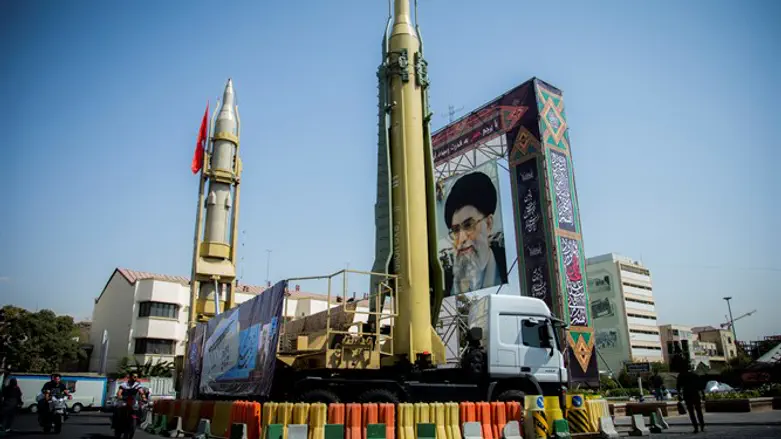
On October 23, four experts of the Institute of Science and International Security (the so-called ‘good ISIS’) published an analysis of documents, photographs and satellite images related to Iran’s covert nuclear program which were seized by the Israeli spy agency Mossad during a daring night-time raid in Tehran, Iran at the end of January this year.
The ISIS report was written by four researchers with wide knowledge of nuclear weapons programs while three of them worked for the International Atomic Energy Agency in Vienna, Austria.
The research of the ISIS team focused on the Parchin military base in Iran which was used to conduct “Iran’s “nuclear weapons research and development effort,” according to David Albright, Sarah Burkhard, Olli Heinonen, and Frank Pabian.
The ISIS report “for the first time publicly correlates photos from inside the main building” at Parchin which was called Taleghan 1 by Iran as well as satellite imagery while the report also “updates the previous discussion of the purpose of the second major building at the site, called Taleghan 2,” according to the researchers.
At Taleghan 1 Iran has been testing “a specialized, difficult to develop, neutron initiator to start the chain reaction in a nuclear explosion,” the report said.
“The new information about Parchin, also known as Taleghan, shows that Iran conducted far more high explosive tests at the site than previously understood,” Albright, Burkhard, Heinonen and Pabian wrote while they suspect Iran of hiding and maintaining at least some of the equipment used at Parchin after the Islamic Republic razed the test chambers and sanitized the soil there.
The ISIS study also contained new images of the test chambers at Parchin which were given to the American think tank by the Israeli authorities while the team also conducted interviews with Israeli officials.
The material studied by the ISIS team “conclusively shows that the Parchin site did house high explosive chambers capable for use in nuclear weapons research and development.”
The conclusions in the report contradict an IAEA report from December 2015 which stated that the Agency assessed that Iran’s activities at Parchin “did not advance beyond feasibility and scientific studies, and the acquisition of certain relevant technical competencies and capabilities.”
The faulty conclusions of the IAEA were to blame on a lack of access to Parchin and the fact that IAEA inspectors only examined one of the buildings there while the Iranians were allowed to take samples of the ground which were then examined by the Agency in Vienna.
Iran also refused to answer all the questions about Parchin raised by the IAEA.
The UN nuclear watchdog did not “at a minimum, asked for clarifications from Iran about any of the allegations (about Parchin) in writing, which is a well-established IAEA practice when such concerns have emerged,” according to the four researchers.
They, furthermore, revealed that the IAEA yet has to fully vet the Iranian nuclear archive obtained by the Mossad despite the fact that Israel handed over the material before Israeli Prime Minister Benyamin Netanyahu published parts of it during a press conference in the IDF headquarters in Tel Aviv in April this year.
Albright, Burkhard, Heinonen and Pabian also wrote that the Board of Governors of the IAEA gathered twice after Netanyahu published parts of the archive but didn’t comment on the new Israeli allegations that Iran has never fully ended its illicit nuclear activities.
Iran’s activities at Parchin “violated its commitments under the Nuclear Non-Proliferation Treaty (NPT) and are contrary to its signing of the Comprehensive Test Ban Treaty,” according to the ISIS team.
The team also confirmed parts of a study by Israeli investigative journalist Ronen Bergman who in September published an essay at TheNew York Times in which he said the material seized by the Mossad proved the Iranian nuclear project “is a mega-scam in which senior Iranian officials and hundreds of people participated for years.”
ISIS confirmed one of the test chambers at Parchin contained a flash x-ray system to examine small-scale high explosive tests.
The system was able to capture the moment of the chain reaction that leads to the detonation of an atomic bomb.
“Such tests may have included high explosives compressing a core of natural uranium, simulating the initiation of a nuclear explosive,” the report said while adding that this could explain why Iran sought to sanitize the destroyed buildings and the surrounding soil in 2012 but nevertheless wasn’t able to prevent the discovery of traces of uranium in ground samples.
Albright, Burkhard, Heinonen and Pabian ask what Iran did with the very sophisticated equipment at Parchin after it razed the test chambers and demanded the remaining participants in the Joint Comprehensive Plan of Action (the 2015 landmark nuclear deal with Iran), as well as the IAEA, should take action to control and monitor the equipment.
“The IAEA needs access to the Parchin site and associated facilities, such as the company or companies where the high explosive chambers were manufactured, as well as individuals identified as having worked during this time period at the site,” the ISIS team wrote at the end of the report.
The team furthermore demanded additional “environmental sampling” which “should be conducted at all the buildings at the site.”
“The inspectors need to see the cut-up chambers and associated equipment and be able to take environmental samples there as well. Iran must have put all of these items somewhere,” according to the four researchers.
“The lack of access to Parchin and other military sites continues to undermine the credibility and independence of IAEA safeguards and the verification of the JCPOA,” the ISIS team wrote before reaching the conclusion that there is no evidence “Iran has abandoned its goal of building nuclear weapons.”
